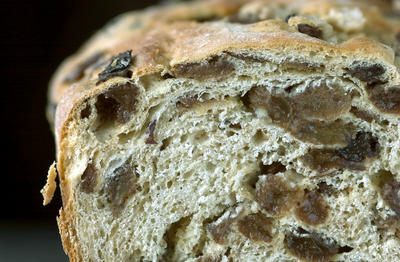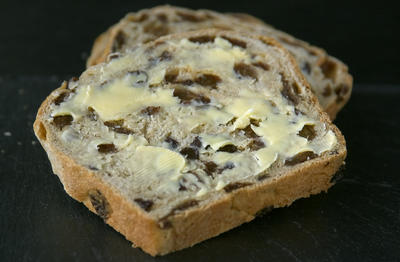
Welsh language for beginners:
Bara means bread, and brith means speckled. So, Bara Brith means speckled bread. 'Os gwelwch yn dda' is 'if you please'. With your new linguistic abilities you can go into any bakery in Wales and order this national classic. The name Bara Brith was originally used in north Wales only. In the south, the name Teisen Dorth was used (teisen means cake, and dorth/torth is loaf). Bara Brith is eaten throughout Wales and is readily available from tea-rooms, cake-shops and food markets. I lived in south Wales for a few years, so have sampled one or two in my time!
Although Bara Brith is referred to as a cake, it is, as its name suggests, a bread. In the days before baking powder and other chemical raising agents most 'cakes' were in fact fruited breads. In this instance the bread is 'speckled' with currants, sultanas and dried peel.
My recipe comes from a book called 'Welsh Country Cooking', by Chris Grant. This book record recipes handed down from the author's great-grandmother to grandmother to mother. I was a bit put off by the idea of including lard, but for authenticity used this instead of butter. When I weighed it out I realised that most cakes I make use a much greater weight of butter, so 20g of lard is not such a big deal. Maybe it's just the word I don't like - lard - say it aloud and clearly it is a substance that is heavy, joyless and cholesterol inducing.

Makes one large loaf (900g/2 lb tin):
275g strong white (bread making) flour
1 level teaspoon salt
20g lard
25g sugar (I used golden caster)
1/2 teaspoon of mixed spice (I didn't have a jar of mixed spice, so used allspice)
1 large beaten egg
1/4 pint/150ml warm water
20g fresh yeast (I used a 7g packet of dried yeast)
225g currants
125g sultanas
25g mixed peel
1. Grease your loaf tin.
2. Sieve flour and salt into large mixing bowl, add the dried yeast if using. Rub in the lard with your fingertips. Make a well in the centre.
3. Mix the sugar and spice together and put into the well.
4. Add the beaten egg to the warm water. If you are using fresh yeast use 3 tablespoons of this mixture to mix the yeast to a thin paste, before adding the remainder of the liquid.
5. Pour the egg and water (and yeast) mixture over the sugar in the well. Mix the dry ingredient in with the liquid, then knead to form a smooth, elastic dough.
6. Mix your fruit in with the dough. (I had soaked my fruit overnight in tea to plump it up, and although I had drained it well mixing in wet fruit was a bit of a messy challenge. I had to use extra flour to lessen the stickiness of the dough.)
7. Put your dough into the loaf tin (or you can make a free-form loaf on a baking sheet), cover and leave to rise for 1 1/2 hours.
8. Preheat oven to 180C/350F/Gas mark 4.
9. Bake for 30/35 minutes, covering top with a foil hat after about 20 minutes. Loaf is done when underside sounds hollow when tapped (I just guess, as I have problems turning a piping hot loaf out of a tin).

This cake/bread gave off spicy and delicious smells whilst baking, and whilst cooling on a baking rack scented the rest of my flat with the same hunger inducing scents. Please only bake this after eating.
Fortunately my guess that the loaf had cooked fully was correct, and after waiting an age for it to cool it was ready for photography and sampling.

The loaf had a good weight, and felt moist rather than dry like a unfruited loaf. The slices cut neatly without the loaf crumbling away, demonstrating a good firmness. The crust on the top of the loaf was thin (rather than crusty) due to the fact that I covered the top up part of the way through the baking time. I have made fruit breads in the past and not shielded the top, ending up with a scorched crust with embedded charred currants - not so good. The Bara Brith was delicious, and didn't really need the addition of butter, however the butter currently in my fridge is Welsh so it seemed to make sense use it.
Blasus!

12 comments:
Anna,
I was poking around the web for some Welsh recipes and ran across your site. What a great a blog! I’ll be back for seconds.
hi anna,
i'm making a loaf of bara brith for my american auntie and was looking for something that said a bit about the bread. what you've written is perfect! would you mind if i printed it off for her, as she doesn't use the internet?
thanks, nessa - south wales
hi again, have just linked you from my own blog. ta. nessa - south wales
Print away! Hope that your Auntie likes the loaf.
I've been searching for bara brith with yeast...now that I find you.... may I ask how much butter you would use instead of the lard...and if you know how much 20 g would be in tablespoons or cups in stead of weight? I will keep looking to see if I can find others...but if you you know...
you could perhaps email me?
vphilion@telus.net
okay....found one that uses butter and got the measurements....
maybe u would like to see it too..
Bara Brith
Hi BumbleVee,
I look forward to seeing your bara brith. Hope that you enjoy it. Stick your feet up, have a cup of tea at an easy arm's length, and tuck into a slice with butter.
The other way of doing this is to substitute cold tea for the warm water, and soak the fruit in that instead.
So I'm told by the wife who is Welsh!
This is nothing like the mid and north-wales recipee that I was bought up on! (Which makes it delightful to know.) I was always told the one thing was that there was no fat (butter, oil or lard) and that it was a good way to use cold tea up which you saoked the fruit. The one we all cook is more of a cake than a loaf, though I have come across the loaf before.
But thank you for sharing and your blog is lovely. I came on to get the scotch pancake recipe because it seemed the closest to the one I rememebred in the bero cook book.
ps. I knoticed you mentioned the use of allspice, which is very different from mixed spice. Mixed spice is just dried corriander root, cinamon and a little bit of ginger and nutmeg.
I've only ever used allspice in savoury recipes before, but will happily give it ago next time I do something sweet.
Great Aunt Maud's version.....
Bara Brith as i know it came courtesy of Maud, her recipe came from the dim and distant past, back into the 1800's perhaps before..
This version is more of a cake than a bread and is absolutely delicious...ONLY ONE RULE...always make 2 together so one can be 'matured' whilst the other inevitably gets eaten straight away.
mauds bara brith
1 large cup of milk
1 large cup of sugar (we use soft brown)
4oz Margarine (usually use butter)
4 tablepsoon of currants (we prefer sultanas)
1 tablespoon glace cherries
1 tablespoon chopped nuts
heat in saucepan and allow to cool
8oz Self Raising Flour
1 teaspoon mixed spice
1/4 teaspoon Bicarbonate of soda
1/4 teaspoon of salt
add to mixture in Saucepan
Beat 2 eggs and add to mixture in Saucepan
Bake for one hour at 350/375 or until firm to touch
hide well or will disappear very quickly
(currants/sultanas/cherries/nuts) these can be varied according to your taste and preference
So lovely to find a recipe using yeast as this is the kind of Bara Brith that I remember from my Nain in Trefriw . I now live on Cardigan Bay and all the ones around here are too cake like and I wanted to make one like I knew from North Wales. Diolch
Post a Comment